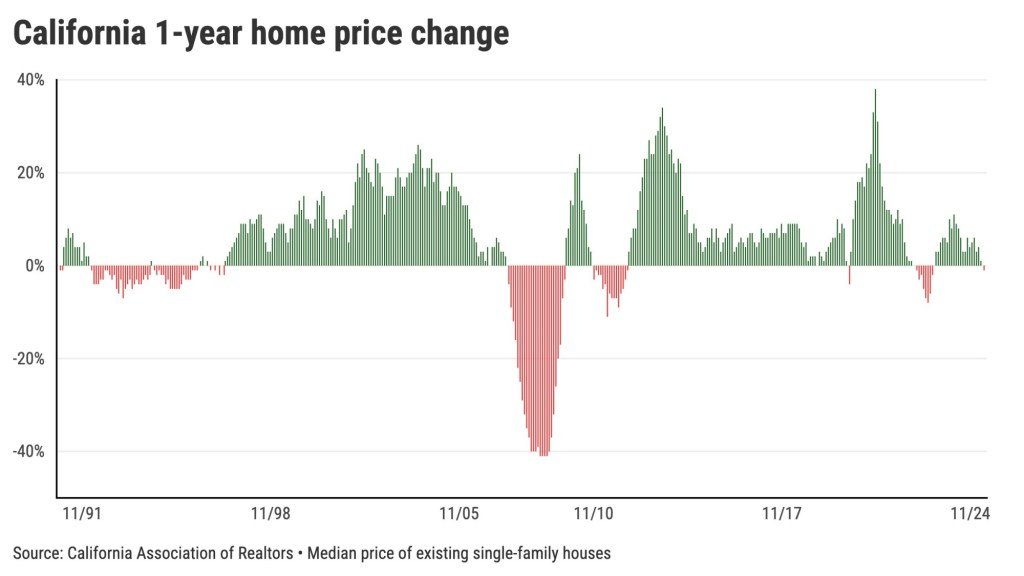Will lower mortgage rates convince California house hunters to stop balking at unaffordable homes on the market?
As the sun sets over the golden hills of Northern California, the vibrant real estate market faces an unexpected crossroads. After years of untouched growth, whispers of lower mortgage rates circulate amidst homebuyers hesitant to plunge into a landscape marked by affordability barriers. Surges in property prices, coupled with rising interest rates, have kept many would-be homeowners at bay. Now, as the Federal Reserve debates further rate cuts, the pressing question takes center stage: Could lower mortgage rates be the break that California’s housing market desperately needs?
The Current Landscape
California’s economy, a robust engine of innovation and technology, has constantly drawn in prospective buyers. However, the reality of homeownership feels increasingly inaccessible. In January 2025 alone, the California Association of Realtors reported that the statewide median home price hovered around a staggering $800,000, with average mortgage rates fluctuating between 6.0% to 6.5%, making homeownership a distant goal for many families.
“When mortgage rates spike, buyers naturally retreat,” says Dr. Mara Callahan, a leading economist at the University of California, Berkeley. “But when those rates fall, it doesn’t guarantee buyers will come rushing back, especially in a market already strained by historically high prices.” Her insights are corroborated by historical data analysis, which shows that while sales typically rise during significant drops in mortgage rates, affordability remains a crucial limiting factor.
Understanding the Rate Dynamics
- Rate Drops: Average sales increased by 5% during the largest mortgage rate cuts since 1990.
- Rate Increases: A 6% decline in sales occurred when rates rose sharply.
- Home Appreciation: The median home price crept up 4% during rate drops but jumped by 7% with rising rates.
- Days on Market: Homes sold faster during rate drops, shortening by an average of four days.
However, there’s an inherent complexity. Historical trends reveal a counterintuitive narrative: significant drops in mortgage rates often coincide with economic turbulence. For instance, when mortgage rates declined, California saw a simultaneous increase in unemployment to 8.2%. Dr. Daniel Voss, a housing market analyst at Stanford University, notes, “It’s paradoxical—lower rates can stimulate buying, but if economic conditions are poor, potential buyers may not have the financial stability to act.” These economic realities capture the delicate balancing act between the thirst for cheaper financing and the necessity of a healthy job market.
The Buyer’s Dilemma
Prospective homebuyers are facing an intricate web of factors. With mortgage rates projected to stabilize or potentially decline, many are left weighing their options. According to a recent survey by the California Housing Forum, 68% of respondents indicated they would consider purchasing a home if mortgage rates fell below 5.5%. However, the same survey revealed that nearly 74% of respondents felt that home prices were simply too high even in ideal financial circumstances.
This sentiment is echoed by Alex Cho, a local real estate agent in San Francisco. “Our open houses are crowded, yet buyers are still hesitant to stretch their budgets,” he notes. “They’re waiting for the right moment, which may never come if prices don’t adjust accordingly.” Cho’s experiences underscore the unpredictable nature of the market; potential buyers are stuck in a cycle of uncertainty, hoping for price corrections that reflect their financial constraints.
Potential Impacts of Lower Rates
Market analysts predict that lower interest rates could lead to an uptick in inventory, as sellers might feel more encouraged to list their homes. “When rates drop, sellers tend to feel more optimistic about their own buying power, which can stimulate more listings,” explains Rebecca Lin, a data analyst with the California Real Estate Institute. Furthermore, this could catalyze a healthier housing turnover, benefitting both buyers and sellers alike. Yet, the actual impact remains contingent on whether prices remain prohibitive.
What Lies Ahead?
The ongoing discussions surrounding the Federal Reserve’s rate adjustments likely hold considerable sway over California’s future real estate dynamics. The current political climate, swirling with heated debates over caps on inflation vs. economic growth, fuels uncertainty for potential homeowners. Experts note that while lower mortgage rates may amplify interest, other factors—primarily job security and income growth—hold equal, if not greater, weight in determining buyer engagement. Historical patterns indicate that home sales flourished during periods of both lower rates and a buoyant job market, suggesting a dual dependency.
“For California to see a viable improvement in home sales, we must address both the financing side and economic conditions,” asserts Dr. Claire Betts, a noted sociologist studying urban development. “It’s not just about who can afford to buy, but whether enough people have the means.” The continued growth of remote work and the tech sector might play a pivotal role in this evolving landscape, as companies embrace the flexibility that allows employees to relocate to more affordable areas.
As the sun slips below the California horizon, the future of the housing market teeters on the intersection of interest rates and economic stability. Homebuyers, standing at a crossroads, must navigate their choices carefully, balancing desire with reality. In a state known for its innovation and resilience, the challenge will be transforming the hope of homeownership into a tangible reality while keeping economic conditions in check. Whether lower mortgage rates will lead to a significant market revival remains to be seen, but one thing is clear: the interplay of these complex factors will define California’s housing narrative for years to come.





